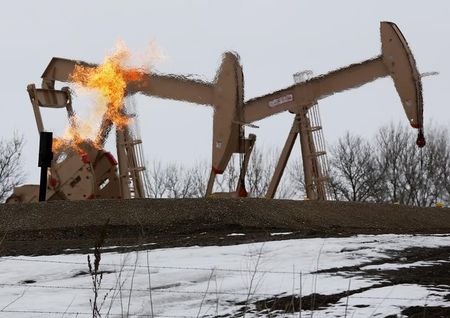Commodities
Oil prices fell on Gaza peace expectations, weak outlook, surplus fears

Investing.com– Oil prices slipped lower Tuesday, falling to their weakest levels since mid-June on growing expectations of a Gaza ceasefire as well as uncertainty over demand growth.
At 09:05 ET (13:05 GMT), fell 0.9% to $81.68 a barrel, while slipped 1% to $77.61 a barrel.
Gaza ceasefire in focus
Oil markets were watching for any new developments in the Israel-Hamas conflict, after Israel signaled that ceasefire talks will resume from this week.
Efforts to reach a ceasefire deal between Israel and militant group Hamas have gained momentum over the past month. U.S. President Joe Biden is expected to meet Israeli Prime Minister Benjamin Netanyahu on Thursday at the White House, and the two are to discuss ways to reach a ceasefire, as well as Iran and other topics.
The war in Gaza has lent support to oil prices as investors priced in the risk of potential disruptions to global crude supply.
Demand worries remain
Markets remained doubtful over the outlook for crude demand, amid growing signs that global economic growth was cooling amid pressure from high interest rates.
Doubts over top oil importer China remained even after the country unexpectedly lowered benchmark interest rates to foster growth. But analysts said the cut was too small to inspire confidence.
The Third Plenum of the Chinese Communist Party also yielded scant cues on planned stimulus measures from Beijing, even as the Chinese economy grew less than expected in the second quarter.
Cooling economic growth bodes poorly for oil demand.
Morgan Stanley sees oil market surplus by 2025
Morgan Stanley analysts warned in a note this week that the oil market will likely shift into a surplus by 2025, with prices expected to fall within the mid-to-high $70s range.
While the market was currently experiencing some tightness, Morgan Stanley said the market was set to reach equilibrium by the fourth quarter.
The brokerage said waning seasonal demand and an expected increase in output from across the globe was set to drive this surplus.
Still, Morgan Stanley expects oil prices to end the third quarter at $86 a barrel, representing some near-term upside from current levels.
US inventories due
U.S. politics were also in focus after President Joe Biden said he will not run for reelection, and endorsed Vice President Kamala Harris as the Democratic presidential candidate.
But both Biden and Harris were seen polling behind Republican nominee Donald Trump, who has flagged plans to increase U.S. oil production if he wins the presidency.
The , a trade group, is due to release its estimates for last week’s oil inventories later in the session, with the official U.S. government data due on Wednesday.
U.S. oil inventories have seen consistent draws over the last few weeks as the summer driving season proceeds to drive demand in the world’s largest consumer.
(Ambar Warrick contributed to this article.)
Commodities
Oil prices rise; U.S. crude inventories plunge, Russia-Ukraine truce eyed
Commodities
India’s Reliance to stop buying Venezuelan oil over US tariffs, sources say
Commodities
Oil prices climb on Venezuela supply worries

 Forex3 years ago
Forex3 years agoForex Today: the dollar is gaining strength amid gloomy sentiment at the start of the Fed’s week

 Forex3 years ago
Forex3 years agoUnbiased review of Pocket Option broker

 Forex3 years ago
Forex3 years agoDollar to pound sterling exchange rate today: Pound plummeted to its lowest since 1985

 Forex3 years ago
Forex3 years agoHow is the Australian dollar doing today?

 Cryptocurrency3 years ago
Cryptocurrency3 years agoWhat happened in the crypto market – current events today

 World3 years ago
World3 years agoWhy are modern video games an art form?

 Commodities3 years ago
Commodities3 years agoCopper continues to fall in price on expectations of lower demand in China

 Economy3 years ago
Economy3 years agoCrude oil tankers double in price due to EU anti-Russian sanctions























